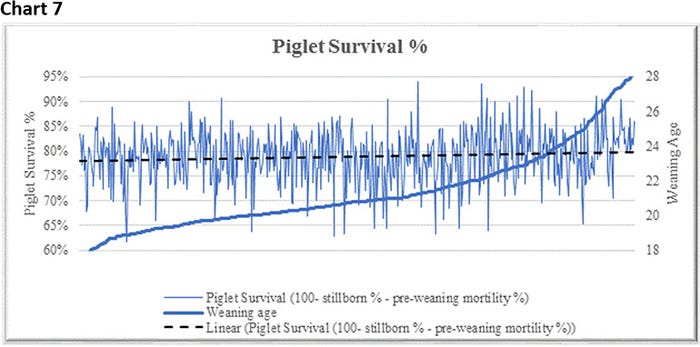Weaning age: What does it cost me to wean an older pig?
Some advantages exist for moving to an older weaning age.

Many of the farms we consult with have been asking about weaning an older pig and what that will do to the farm's productivity. We have selected 601 farms from the Swine Management Services Benchmarking database, all with 20-plus pigs weaned per mated female per year. We rounded the weaning age to the nearest whole number, and Table 1 shows the ranges for each weaning age.

To look at the variation in weaning age by day of the 601 farms, Chart 1: Number of farms was created. It shows that 70.7% of the selected farms are weaning between 19 to22 days, only 29 farms (or about 4.8% of all farms) at 18 days and only 11.6% of farms over 25-plus days.

The second thing we looked at was the farm size, Chart 2: Average mated female inventory. It shows farms size going down as weaning age goes up, farms weaning at 24 days average 706 mated females average and farms weaning at 28 days average 853 mated females.

We first looked at Chart 3: Litters per mated female per year. The trend line shows the expected decrease as the weaning age increases, but the variation by farms is very large against the trend line. There are several ways to increase the weaning age without changing the farm flow. In barns designed to turn the farrowing crate 13-plus times per year, the average weaning age will vary from 18 to 22-plus days depending on how many times a week you wean and also farrowing rooms are loaded by expected farrowing date based on previous gestation length. Weaning once a week will yield weaning age of 18 to 19 days, while farms weaning five times per week can get a weaning age of 22. Variation in the number of females bred per week and farrowing rate will dramatically affect the weaning age.

Chart 4: Variation in breeding versus weaning age is a case study from the last 52 weeks, with the farm weaning twice per week and averaging 29 pigs weaned per mated female per year. It shows how the variation in females bred and farrowing rate affects the average weaning age. Weekly weaning age varies from 19.8- to 23.7-day-old pigs.

We also would expect a decline in total born. Chart 5: Total born per mated female per year shows that as weaning age increases total born goes down. However, there is again a huge variation between farms. The average for all farms is 35.37 total born, with a range of 24.7 to 44.6. There are 70 farms weaning over 25 days, 30 of the 70 farms are over 35 total born per mated female per year. This shows that weaning age is the not the sole factor in determining farm performance.

In Chart 6: Pigs weaned per mated female per year, the number the industry compares themselves with, the average for all farms is 27.13, with a range of 20.2 to 34.4. Like some of the other charts show, there exists a large amount of farm-to-farm variation by weaning age with a farm weaning at 27 days at 33 pigs weaned per mated female the last 52 weeks.

If you are moving to an older weaning age, some advantages may be being able to sell older pigs for more dollars, reducing feed cost for starting pigs in the nursery, a need to wean bigger pigs to meet a contract obligation, or being able to increase the value of the pigs by increasing weaning weight bonuses. As pointed out in some of the charts, you will probably see some drop in farrowing crate usage, and some drop in total pigs born. That will have some effect on output of pigs weaned weekly from the farm. This reduction in production probably will lead to an increased cost per pig produced.
How do you then wean more pigs per farrowing crate? Most of this is affected by piglet survival (100 minus stillborn percent minus pre-weaning mortality percent) which is shown in Chart 7: Piglet survival percent. The trend line for this chart is flat for farms with weaning age of 18 to 28 days. What you should really note is the farm-to-farm variation which shows a range of 63% to 93% survival. For example, if a farm drops annual production by 1%, the farm needs to improve piglet survival by 3% to get the extra pigs back (0.36 pigs per sow per year times 3% equals 1.02 pigs extra per sow per year). That would mean some changes in farrowing house management to lower stillborn pigs, pre-weaning mortality percent or both to get that extra 1.02 pigs.

Table 2 provides the 52-week rolling averages for the 11 production numbers represented in the SMS Production Index. The numbers are separated by 90-100%, 70-90%, 50-70%, 30-50% and the 0-30% groups. We also included the 13-week, 26-week and 12-quarter averages. These numbers represent, what we feel, are the key production numbers to properly evaluate the farm's performance.

At SMS, our mission statement is to provide "Information solutions for the swine industry." We feel with the creation of different SMS Benchmarking databases for all production areas, we now have more detailed information to share with the swine industry. If your farm would like to be part of the SMS Benchmarking databases, or if you have suggestions on production areas to write columns about, contact Mark Rix, Ron Ketchem or Connor Sharp. We enjoy being a part of the NHF Daily team. Previous columns can be found at NationalHogFarmer.com.
Sources: Ron Ketchem, Mark Rix and Connor Sharp, who are solely responsible for the information provided, and wholly own the information. Informa Business Media and all its subsidiaries are not responsible for any of the content contained in this information asset.
About the Author(s)
You May Also Like




